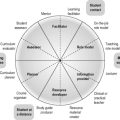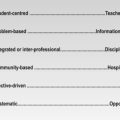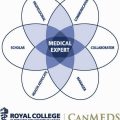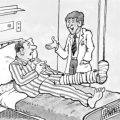18 Recognising the importance of the education environment
What is the learning environment?
We can read the curriculum documents, we can inspect the expected learning outcomes, and we can experience a wide range of teaching approaches, but we may know little about the student’s experience in the education programme. Key to this, suggests Genn (2001), is the atmosphere or climate experienced by the student in the school – what is valued, what is recognised and what is encouraged. As Genn describes, the education climate is the soul and heart of the medical school. It is the education environment that determines the students’ behaviour, their achievements and their satisfaction. McAleer et al (2009) likened it to the climate or environment in the meteorological context and suggested that we cannot hope to maximise the education output if we do not foster a nurturing climate.
The education climate is important
• In the medical school or training programme is collaboration or competition between students encouraged?
• Is the student encouraged to ask questions and think creatively or to participate passively and follow the rules?
• Is the curriculum about meeting the needs of the learner or the needs of the teacher?
• Does the curriculum challenge and stretch students or require only minimum competence?
• Is the environment a trusting one where the teacher is supportive and tolerant of mistakes or is the teacher viewed with suspicion as the ‘enemy’ of the student?
Without an examination of the education environment these questions go unanswered. Genn (2001) suggests “If we wish to describe, assess, or otherwise ‘get a handle on’ the curriculum in a medical school, we need to consider the environment, educational and organisational, associated with the curriculum and the medical school”.
Aspects of the education environment
Student or teacher orientation
The education environment may be one in which the teacher is more valued than the student. In a student-centred environment what is valued is the learner, and their interests and student independence and autonomy are encouraged, as discussed in Chapter 13.
The effects of the environment
The educational climate may manifest itself in a number of ways:
• The education environment makes a unique and notable contribution to the prediction of student achievement and success.
• The motivation of the learner is influenced by the education environment in which he or she is studying.
• Many factors influence career choice but undoubtedly the education environment can have a significant impact. Preference for a career as a surgeon in an academic centre, or for a career as a general practitioner in a rural community, may be attributed to the education environment in the training programme.
• Staff may be more inclined to stay in a post if an institution has a good education environment. It is easier to attract new staff to such an institution.
Assessment of the education environment
DREEM has five subscales as described in Appendix 12:
1. students’ perceptions of learning
2. students’ perceptions of teachers
3. students’ academic self-perceptions
Instruments have been developed to assess the education environment in postgraduate education (PHEEM), in the anaesthetic theatre (ATEEM) and in the surgery theatre (STEEM) (Roff 2005).
The use of environment measures
Measurements of the education environment can be used to:
• establish the profile for an institution and gain a holistic view of the curriculum
• understand students’ perceptions of the education environment they have experienced and compare it with their perception of the ideal environment
• compare the perceptions of the different stakeholders including staff, students and managers
• compare the environment as it exists in different departments or attachments within a school and at different phases of the training programme
• provide the medical school or postgraduate body, as a ‘learning organisation’, with an indication of what may be lacking in their programme and where change may be necessary, while at the same time nurturing aspects where no change is required
• assess the effect of a change made in the curriculum, comparing the education environment before and after the change
• compare the environment of different medical schools or geographical settings.
Reflect and react
1. Think about what type of learning environment you would wish to have as a student and how this compares with the environment that exists in your training programme.
2. If information is not already available, measure the education environment in your teaching situation using one of the tools available. On the basis of the results think about how the programme could be improved.
3. Reflect on how your own teaching and attitudes contribute to the education environment as perceived by students or trainees.
Genn J.M. Curriculum, environment, climate, quality and change in medical education – a unifying perspective. AMEE Medical Education Guide. No. 23. Med. Teach.. 2001;23:445-454.
A key text on the subject that merits careful reading.
Hoff T.J., Pohl H., Bartfield J. Creating a learning environment to produce competent residents: the roles of culture and context. Acad. Med.. 2004;79:532-540.
Holt M.C., Roff S. Development and validation of the Anaesthetic Theatre Educational Environment Measure (ATEEM). Med. Teach.. 2004;26:553-558.
McAleer S., Soemantri D., Roff S. Educational environment. In: Dent J.A., Harden R.M., editors. A Practical Guide for Medical Teachers. third ed. London: Elsevier; 2009:64-70. (Chapter 9).
Roff S. Education environment: a bibliography. Med. Teach.. 2005;27:353-357.
A list of over 100 relevant articles.
Roff S., McAleer S., Harden R.M., et al. Development and validation of the Dundee Ready Education Environment Measure (DREEM). Med. Teach.. 1997;19:295-299.
The first description of this important inventory.
Roff S., McAleer S., Skinner A. Development and validation of an instrument to measure the postgraduate clinical learning and teaching educational environment for hospital-based junior doctors in the UK. Med. Teach.. 2005;27:326-331.
Shobhana N., Wall D., Jones E. Can STEEM be used to measure the educational environment within the operating theatre for undergraduate medical students? Med. Teach.. 2006;28:642-647.







